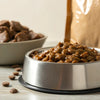Should I Switch My Dog to Wet Food? Exploring the Benefits and Considerations
- Houndsy
Table of Contents
- Introduction
- The Basics: Understanding Wet and Dry Dog Food
- Health Considerations: Is Wet Food Good for Dogs?
- Transitioning to Wet Food: When and How
- Mixing Wet and Dry Food: A Balanced Approach
- Conclusion
- FAQ Section
Introduction
As devoted pet parents, we want nothing but the best for our furry friends. Studies show that about 67% of households in the U.S. own pets, and for many of us, our dogs are not just pets; they’re family members. This love leads us to consider every aspect of their care, including nutrition. One of the most common questions we encounter is, should I switch my dog to wet food?
Wet and dry dog food can both provide complete and balanced nutrition, but they differ significantly in texture, moisture content, and digestibility. Given the ever-increasing options in pet food—a labyrinth of flavors and formulations—deciding whether to switch can feel overwhelming. Our mission at Houndsy is to simplify the dog-feeding experience, and in this post, we’ll delve into the pros and cons of wet food, examine when a switch might be beneficial, and discuss how to make the transition smoothly.
By the end of this article, you’ll have a clearer understanding of whether wet dog food is the right choice for your pet and how to enhance your dog’s feeding ritual while keeping in mind their unique needs. So let’s embark on this journey to elevate the feeding experience for our beloved canines.
The Basics: Understanding Wet and Dry Dog Food
When examining our dog's nutrition, it’s vital to understand what constitutes wet and dry dog food.
What Is Wet Dog Food?
Wet dog food generally comes in cans or pouches and has a much higher moisture content—typically up to 78% compared to about 10% in dry kibble. The processing of wet food involves cooking meat and then combining it with a gravy or broth before canning it. This preparation results in a product that's often high in protein and appealing to our pets due to its texture and smell.
Benefits of Wet Dog Food:
-
Higher Moisture Content:
- Wet dog food is an excellent hydration source, especially for dogs that don’t drink enough water. This is particularly beneficial for older dogs or those with urinary issues.
-
Enhanced Palatability:
- The rich aroma of wet food makes it more enticing, especially for picky eaters or dogs recovering from illness.
-
Easier to Chew:
- The softer texture can be beneficial for senior dogs or those with dental problems, enabling easier consumption.
-
Feeling of Fullness:
- Many pet parents find that wet food helps their dogs feel full longer, which can assist with weight management.
What Is Dry Dog Food?
Dry dog food, commonly known as kibble, consists of processed ingredients shaped into small, crunchy pieces. Dry food is convenient, as it can be left out for extended periods without spoiling and is generally more affordable compared to wet food. It also helps by mechanically cleaning the dog's teeth as they chew, potentially reducing the risk of dental issues.
Benefits of Dry Dog Food:
-
Convenience:
- Dry food is easy to store, measure, and serve, making it practical for pet owners with busy lifestyles.
-
Financially Feasible:
- Generally, dry food is less expensive than its wet counterpart, allowing for more affordable feeding options in the long term.
-
Dental Health:
- The crunchiness of kibble may encourage chewing and can help promote dental health.
-
Versatility:
- Kibble can be used with feeders, puzzles, and toys, adding enrichment to mealtime.
Health Considerations: Is Wet Food Good for Dogs?
While both wet and dry foods can offer balanced nutrition, there are specific health benefits and drawbacks to consider.
Advantages of Wet Dog Food
-
Hydration Support:
- Dogs that struggle with hydration will benefit from the increased moisture in wet food, which can aid digestion and overall health.
-
Easier Adaptation for Aging Dogs:
- For senior dogs facing dental issues or reduced appetite, transitioning them to a wet diet can stimulate better eating habits due to its appealing smell and softer texture.
-
Nutritional Variability:
- Wet food often has a broader range of flavors and ingredients, allowing us to cater to our dog’s preferences and nutritional needs more Flexibility.
Potential Downsides of Wet Dog Food
-
Dental Concerns:
- Wet food can lead to faster tartar buildup since it doesn’t provide the scrubbing effect that kibble does. Regular dental care is essential to mitigate this risk.
-
Storage and Spoilage:
- Once opened, wet food needs refrigeration and can spoil quickly, creating potential waste if not managed properly.
-
Cost Factor:
- Wet dog food is generally more expensive than dry food, especially if used as the primary diet.
Transitioning to Wet Food: When and How
If you’re leaning toward switching to wet food, it’s crucial to consider your dog’s individual needs. Here are a few scenarios that might prompt a change:
- Picky Eater: If your dog turns their nose up at dry kibble, trying wet food might just do the trick.
- Senior Dog: As dogs age, they may prefer softer food that’s easier to chew.
- Health Issues: Dogs with specific health conditions may benefit from the nutritional properties of wet food, especially those related to hydration and appetite.
How to Transition
Switching from dry to wet food requires careful planning to avoid digestive upset. Here’s a simple guide to help you through the transition process over a period of 7-10 days:
-
Start Slow: Begin by mixing a small amount of wet food into your dog's regular dry food. Aim for a ratio of 25% wet food to 75% dry.
-
Gradual Increase: Each day, slightly increase the proportion of wet food while decreasing the dry food. For example, shift to a 50:50 ratio by Day 3 and continue adjusting accordingly.
-
Reflect on Tolerance: Monitor your dog’s reaction to the change. Watch for any signs of digestion issues, such as upset stomach or changes in stool quality.
-
Secure Storage: Ensure that once opened, wet food is promptly refrigerated to maintain freshness and reduce waste.
-
Regular Vet Check-ins: Consult with your veterinarian throughout the process to ensure your dog is handling the transition well and to make sure their dietary needs are met.
Mixing Wet and Dry Food: A Balanced Approach
In some cases, offering a combination of wet and dry food might provide the best of both worlds. This hybrid approach can:
-
Enhance Palatability: The mix can appeal to picky eaters who may enjoy the blend of textures and flavors.
-
Improve Hydration: While providing moisture through wet food, the situation can also lead to the dental benefits of dry food.
However, it’s essential to carefully measure portions to avoid overfeeding and ensure each dog is receiving the necessary nutrients.
Conclusion
The choice between wet and dry dog food ultimately comes down to your dog’s unique health and lifestyle needs. By understanding the benefits and drawbacks of each option, we can make informed choices that contribute to our pets' overall well-being.
Whatever decision we make, our goal remains the same: to provide the best nutrition and feeding experience possible for our furry companions. If you’re considering a switch or looking for further inspiration on elevating your dog’s daily feeding ritual, we invite you to explore the Houndsy Kibble Dispenser. This innovative product not only ensures perfect portion control but also harmonizes marvelous design with function, bringing happiness to both you and your pet.
FAQ Section
Q: Is wet food better for my dog?
A: Wet food has several advantages, such as higher moisture content and enhanced palatability, making it great for picky eaters or those needing hydration. However, the best choice depends on your dog’s individual needs.
Q: Can I feed my dog only wet food?
A: Yes, many dogs thrive on a diet solely composed of wet food, provided that it meets their nutritional requirements.
Q: How do I know if my dog needs a diet change?
A: If your dog is hesitant to eat, has dental issues, or shows signs of dehydration, it may be time to consider a switch to wet food. Consulting with your veterinarian is always a wise move.
Q: Will my dog get overweight on wet food?
A: It’s a common myth that wet food causes weight gain. Many wet foods are lower in carbohydrates and can be effectively used for weight management. However, monitor your dog’s overall intake and consult with your vet.
Q: How should I transition my dog to wet food?
A: Gradually introduce wet food by mixing small amounts with their current diet over 7-10 days to help prevent digestive upset.












